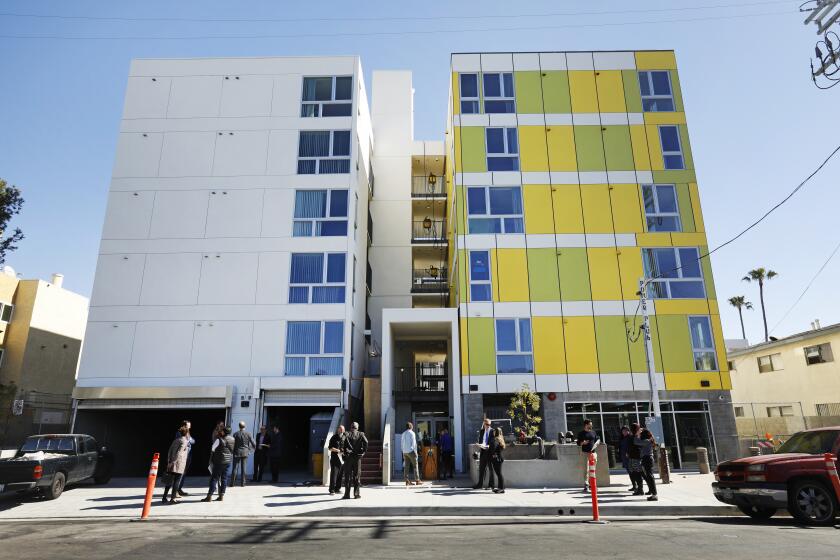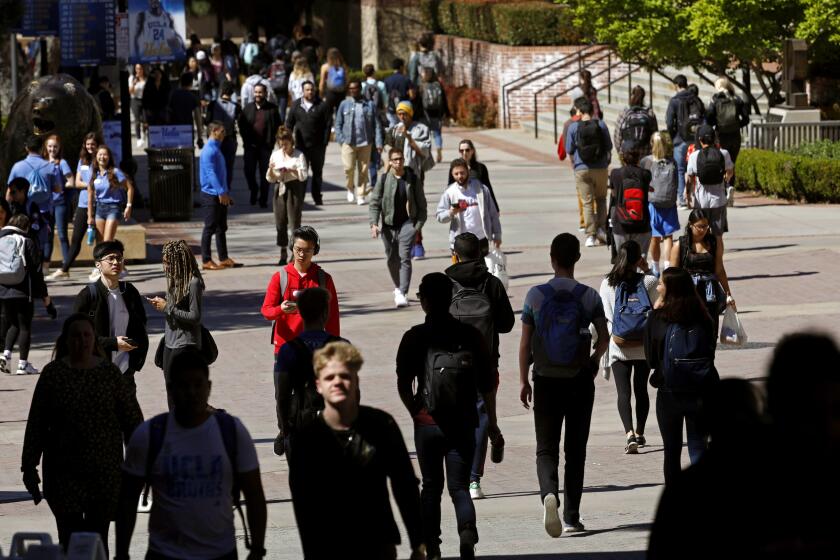Op-Ed: How do we keep L.A.’s housing costs affordable? Build more homes

- Share via
Southern California has several housing crises. “Starter homes” cost hundreds of thousands of dollars. Rent burdens are crushing the working-class tenant majority. And Los Angeles’ lower-income neighborhoods are the most rapidly gentrifying communities in the entire country, pricing out many.
None of these symptoms of our housing policy failures, however, are as tragic as the homelessness crisis. Despite investments in supportive housing and services, the number of Angelenos who struggle to stay housed has remained unacceptably high. Further, Black Angelenos are nearly seven times as likely to experience homelessness as the rest of L.A. County.
Accordingly, new Mayor Karen Bass has made homelessness her top priority. Bass has declared a state of emergency, an unusual step for a human-made disaster. The declaration gives her power to convert hotel rooms into housing, sign master leases for entire buildings and expedite housing approvals. She is determined to see more temporary shelters and subsidized housing be built.
Building public housing in a recession would be cost effective — and accelerate California’s ability to solve its affordable housing crisis.
The road here will not be easy. If done poorly, such programs can violate individual rights and pit police and outreach workers against the unhoused and their advocates. The mayor is reportedly modeling her “Inside Safe” program on previous controversial encampment clearances, such as last year’s in Echo Park.
Moving people into temporary quarters might seem like the only quick solution, but any approach that relies on shelters runs counter to the research evidence that permanent housing solutions are both less costly and more effective.
Let’s hope that Bass will provide more specifics about how she intends to address the long-term problems with our housing and land-use policies that continue to make rents — and thus homelessness — rise. Getting people off the street makes only a small dent in the problem if those people are replaced by new distressed renters. When talking about building housing, Bass has spoken only about subsidized housing. Subsidized housing is essential, but stopping the flow of people into homelessness requires building more housing of all kinds, including market rate.
We do not build enough homes. Research is clear that more housing production in a region is necessary to keep housing costs affordable. And the numbers in Los Angeles don’t lie. The city used to be zoned for 10 million housing units until the 1980s, when we started limiting the number of housing units that could be built on parcels across the city. Now, our zoned capacity is down to about 4 million housing units. Accordingly, Los Angeles built fewer housing units in the 2010s than in each of the previous two decades.
People often cast subsidized and market-rate housing against each other, but they are complementary. Allowing more and faster production of market-rate housing can slow the pace at which rent rises and make our housing subsidy dollars go further. Unfortunately, what many residents know best about the supportive housing built or in production through Proposition HHH is that it costs more than $500,000 per unit to build. The cost to the city and its taxpayers is approximately $120,000 per unit, because HHH funds represent only one layer in a complicated financing stack. But our restrictive zoning and land use policies reduce the available parcels where housing can be built with HHH funds or other subsidies, and makes land acquisition costs extremely high. Neighborhood opposition also makes it hard to build even on publicly owned land.
Some critics of new development often cite gentrification as a reason to limit new market-rate housing, assuming that new housing makes neighborhoods more attractive and expensive. But studies show that even in lower-income neighborhoods, housing production helps keep rents from rising faster than when we do not build at all. This is counterintuitive, but developers are often responding to the conditions that cause rents to rise, not making them increase through housing production.
When we don’t build housing, the gentrifiers can choose only among existing housing units, most of which already have renters. Landlords can (and will) decide not to renew leases or will hike rents up so high that the incumbent renters must leave. If we build new housing, the neighborhood will still change, but incoming renters have somewhere to go that’s not already occupied.
It would be great if we could build enough subsidized homes for the most vulnerable. Unfortunately, doing this would require billions of dollars, especially if we do not take the hard steps to make it easier to build.
It’s possible that multigenerational housing arrangements, created by socioeconomic pressures, could result in more tolerance for divergent views.
So, what should we do? The state Legislature has moved forward on key fronts that shows how we can make it easier to build housing more quickly. After this legislation, annual permits to build accessory dwelling units in California — such as tiny houses behind existing homes — leapt to 16,000 in the first year from 6,000, slowly sprinkling density into mostly single-family neighborhoods. And the state finally removed expensive parking mandates near transit.
L.A. should lift these requirements across the city, as all neighborhoods here are relatively accessible to jobs. Allowing accessory units is not nearly enough to solve the housing crisis. We also need to allow three- and four-unit buildings in what are now single-family neighborhoods. The state has also worked to push cities to permit more density in higher-income neighborhoods. The L.A. City Council has adopted such a plan, and Bass should lead on this initiative as details are ironed out in the coming months.
The homelessness crisis is an emergency, and the mayor is right to treat it as one. But if we don’t build more housing of all types, we are sustaining homelessness, not solving it.
Michael Lens is a professor of urban planning and public policy, and associate faculty director of the Lewis Center for Regional Policy Studies at UCLA.
More to Read
A cure for the common opinion
Get thought-provoking perspectives with our weekly newsletter.
You may occasionally receive promotional content from the Los Angeles Times.












